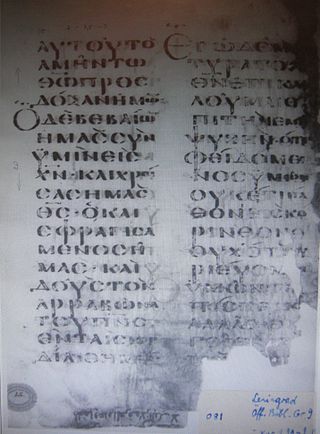Uncial 065, ε 1 (Soden), is a Greek uncial manuscript of the New Testament, dated paleographically to the 6th century
Uncial 066, α 1000 (Soden), is a Greek uncial manuscript of the New Testament. Palaeographically it has been assigned to the 6th-century.
Uncial 067, ε 2 (Soden), is a Greek uncial manuscript of the New Testament, dated paleographically to the 6th century.
Uncial 079, ε 16 (Soden), is a Greek uncial manuscript of the New Testament, dated paleographically to the 6th century.
Uncial 080, ε 20 (Soden), is a Greek uncial manuscript of the New Testament, dated paleographically to the 6th century.

Codex Tischendorfianus II – designated by Uncial 081 α 1023 (Soden), – is a Greek uncial manuscript of the New Testament, dated paleographically to the 6th century.
Uncial 095, α 1002 (Soden), is a Greek uncial manuscript of the New Testament, dated paleographically to the 8th-century.

Uncial 097, α 1003 (Soden), is a Greek uncial manuscript of the New Testament, dated palaeographically to the 7th-century.
Uncial 0107, ε 41 (Soden), is a Greek uncial manuscript of the New Testament, dated paleographically to the 7th-century. Formerly it was labelled by Θb.
Uncial 0108, ε 60 (Soden), is a Greek uncial manuscript of the New Testament, dated paleographically to the 7th-century. Formerly it was labelled by Θd.
Uncial 0136, ε 91 (Soden), is a Greek-Arabic diglot uncial manuscript of the New Testament, dated palaeographically to the 9th century. Formerly it was labelled by Θh.
Minuscule 251, ε 192 (Soden), is a Greek minuscule manuscript of the New Testament, on parchment. Paleographically it has been assigned to the 12th century. The manuscript has complex contents.

Minuscule 568, ε 189, is a Greek minuscule manuscript of the New Testament, on parchment. Palaeographically it has been assigned to the 10th century.
Minuscule 566, ε 93 (Soden), also known as the Empress Theodora's Codex. It is a Greek minuscule manuscript of the New Testament, on parchment, dated palaeographically to the 9th century.
Minuscule 570, ε 1220, is a Greek minuscule manuscript of the New Testament, on parchment. Palaeographically it has been assigned to the 12th century. The manuscript is lacunose. It was labelled by Scrivener as 479.
Minuscule 572, ε 1221, is a Greek minuscule manuscript of the New Testament, on parchment. Palaeographically it has been assigned to the year 12th century. It was labeled by Scrivener as 480. The manuscript has not complex contents.
Minuscule 574, ε 1295, is a Greek minuscule manuscript of the New Testament, on parchment. Palaeographically it has been assigned to the 13th century. The manuscript is lacunose.
Minuscule 653, ε 182, is a Greek minuscule manuscript of the New Testament, on parchment. It is dated by a colophon to the year 1077. The manuscript has not complex contents. Scrivener labelled it by 640e.
Uncial 0321, ε 2 (Soden), is a Greek uncial manuscript of the New Testament, dated paleographically to the 5th-century. The manuscript has survived in very fragmentary condition.
Minuscule 938, ε 1451 von Soden), is a 14th-century Greek minuscule manuscript of the New Testament on parchment. The manuscript has survived in complete condition. It contains some liturgical matter.



